How to Visit Istanbul’s Topkapi Palace Guide: 20 Top Questions Answered

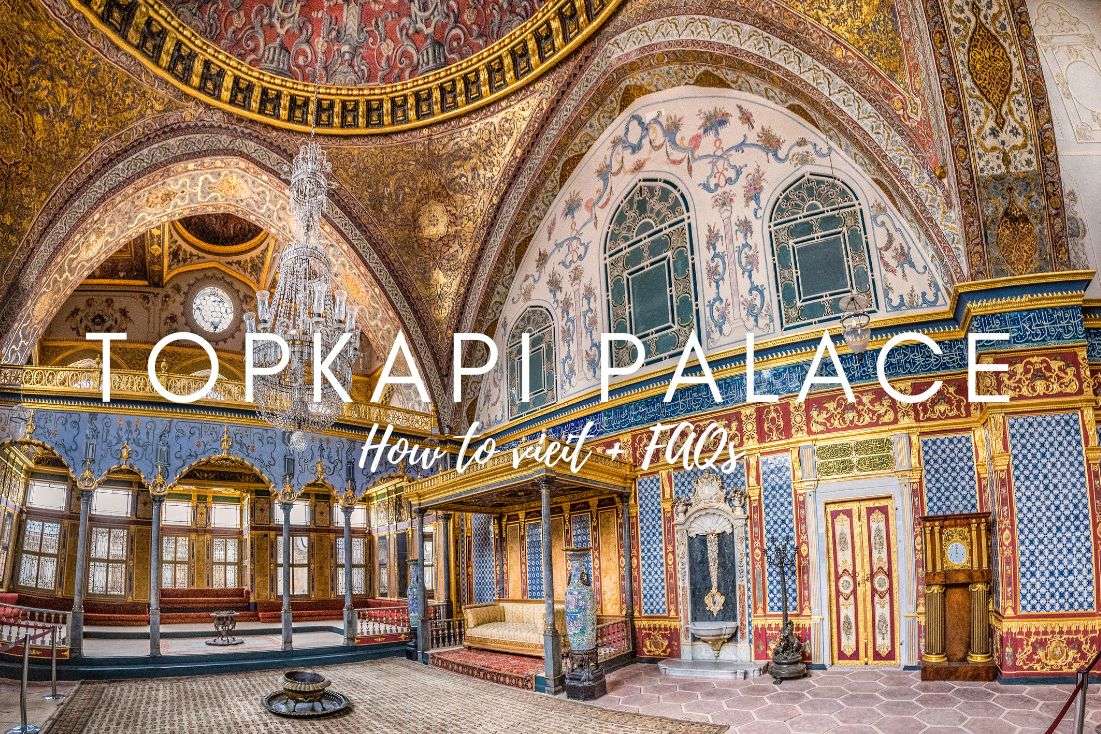
In Istanbul, there's a whole array of places worth seeing, but Topkapi Palace is my clear number one. This lavish palace served as the residence of the sultans of the Ottoman Empire for nearly 400 years. Your jaw will drop in awe when you visit, heck, you could spend your youth here! And I recommend you do, because it's totally worth many hours of your time. I spent full day in Topkapi and still remember it with tear of joy in the eye.
Tip: Another palace that’ll knock your socks off? The Alhambra in Granada.
You don't have to be a die-hard history buff like me to be captivated by this place and want to learn everything about it. And if a whole day of walking and history gets a bit much, I've got a tip for an amazing Ottoman-inspired relaxation session—a Turkish hammam (one of the best things we did in Istanbul).
If you're a planning wizard who doesn’t like to leave things up to chance, I bet you'll want to get properly prepped and informed before visiting Topkapi Palace. And as always, I've got your back. You can flex in front of your family about how well you prepared, while I dish out all the answers to your questions—from historical background to dress code—in one fab article.
You might also be interested in reading:
- 3 Days in Istanbul Itinerary
- What Happens in a Hamam in Istanbul: Our Experience
- The 4 Best Areas to Stay in Istanbul
- What to Eat in Istanbul: Our 13 Top Tips
- 29 Istanbul Travel Tips: From Haggling at the Bazaars to Tourist Scams
1. What is Topkapi Palace?
Nowadays, Topkapi Palace is a museum and a library. But what's far more intriguing is what Topkapi Palace used to be. It used to be the stomping grounds of Ottoman sultans from the 1460s until the 19th century, though it gradually lost its cool factor when new palaces (like the Dolmabahçe Palace) started being built along the Bosphorus and the sultans preferred to hang out in them instead. In 1856, they moved out of Topkapi altogether to Dolmabahçe Palace.
Fun Facts about Topkapi Palace Museum
- Topkapi Palace is really big - 700.000 square meters. (Imagine the price of the property in that area of Istanbul. Those Sultans were rich!)
- There were at least 700 people working in the kitchens preparing food for over 4.000 people.
- Harem has over 400 rooms. It was a very long walk for me.
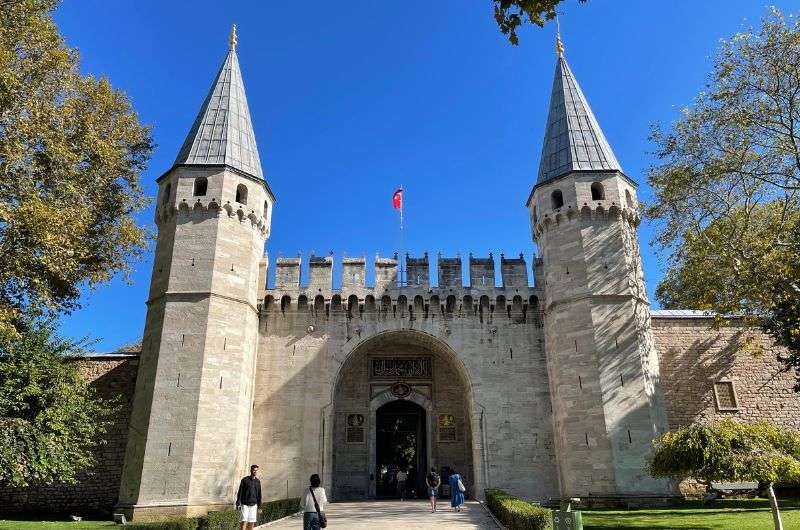
A large complex full of interesting sights - Topkapi Palace
So, today you have the chance to wander through courtyards, pavilions, and grand rooms, marveling at the beauties of Ottoman architecture. And with a bit of imagination, you can also picture how the rulers (and their concubines) from the Ottoman Empire lived.
In the second half of this article, I dive into the details of everything that's part of the palace—we'll take it courtyard by courtyard and lay out all the details.
2. What is special about Topkapi Palace?
Topkapi Palace is special because it served as the main residence and administrative hub for the Ottoman sultans for nearly 400 years, making it the central point for the governance of the Ottoman Empire. Get it? This place was where history (at least the Ottoman part) was made.
But that's not all; Topkapi Palace is also a stunning example of Ottoman architecture and a rich legacy of the Ottoman Empire. Ottoman architecture blends various styles developed over centuries. Actually, in Istanbul, you'll find more buildings in the Ottoman style, like the Blue Mosque or Hagia Sophia. By the way, both of these spots are on my list of 14+2 Best Places to Visit in Istanbul.
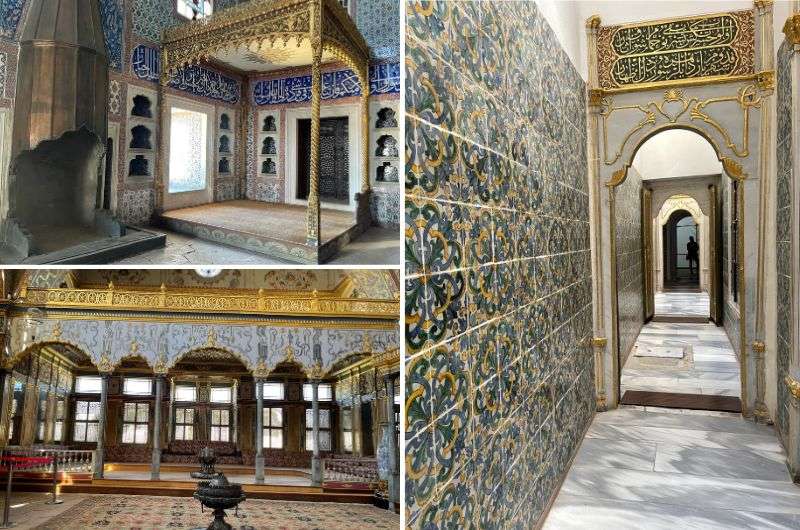
The very non-minimalist decor of Topkapi Palace
If you've ever visited a mosque, it probably won't be hard for you to guess the main features of Ottoman architecture. Yes, it's the grand domes, minarets and fountains. What's also typical of this style is the rich decoration in the form of colorful patterns, mosaics, and ceramics. I'm telling you, your eyes will be darting all over the place. Hand on heart, you wouldn't want it at your home but seeing it here is something unforgettable.
Topkapi Palace's mark of excellence is also stamped by UNESCO World Heritage, which I usually doubt in sensible reason for putting some places on the list, a great example is Telč in Czech Republic. The complex was listed in 1985 as part of the historic center of Istanbul.
3. How many sultans lived in Topkapı?
30 sultans lived in Topkapi Palace, starting with Mehmed II, who conquered Constantinople and had the palace built. After Mehmed II, sultans resided there for another four centuries.
Of course, the sultan didn't live there alone. Typically, 1,000–4,000 people lived in Topkapi Palace, with 300 of them residing in the Harem.
Hotel tip: If you want to feel like a sultan too, book yourself a room at AJWA Sultanahmet. It’s a 5-star hotel that gives you luxurious Ottoman style complete with hand-made carpets, hand-painted tiles, exquisite bedding, and an overall wow factor. The common areas with art by the best Turkish artists.
4. Who was Topkapi Palace built for?
Originally, the palace was built for Sultan Mehmed II. The construction of the original palace took place from 1460 to 1478 to celebrate the conquest of Constantinople. Now that's how you celebrate... no one's ever built me a palace for a party!
After its construction, it served the Sultans for the next four centuries (I know I've already said it, but four centuries is pretty intense). Over the years, it was gradually renovated and embellished based on the wishes of the reigning sultan. In 1924, it was transformed into a museum, and now you and I get to visit and stare at the wonder of it.
5. How do you get to Topkapi Palace?
You can reach Topkapi Palace by public transport, on foot, or by taxi. It really depends on where you're coming from, but assuming you're staying in a centrally located hotel, I'll venture a guess that you'll probably be walking. See my article on the best areas to stay in Istanbul if you’re still pondering staying anywhere outside of Sultanahmet.
But let's say you've decided to take a tram—hop on the T1 and get off at Sultanahmet stop. If, for some wild reason, you need to take the train, head to the Marmaray Sirkeci Station stop on the Marmaray line (Atakoy-Pendik). If you're looking to cool off underground before your visit, take the M2 metro to the Vezneciler station. The last option is to use the bus, but I doubt anyone wants to go for that.
Topkapi's main entrance is right behind the Hagia Sophia. Though It was a bit hassle to find it. If I were to do it again I would put it in google nav, because it took me a while to find it without that.
This is the spot where you will wait at least 40 minutes to get in (see on google maps)
6. How much is the Topkapi Palace ticket price?
Topkapi Palace ticket price start at 180 TL (about USD 6). As you might expect from experience with other landmarks, there are several ticket options available, granting access to different parts of the site. For me, the best deal is the ticket priced at 650 TL (USD 21), which allows entry to all areas, including Topkapi Palace, Hagia Irene, and the Harem.
If you're not keen on visiting the Harem, you can get a ticket for Topkapi Palace and Hagia Irene for 500 TL (USD 16). Another option is to buy a ticket just for the Harem for 225 TL (USD 7) or just for Hagia Irene for 180 TL (USD 6). But to get there, you also need a ticket to Topkapi Palace. See the logic there? Neither do I; classic Turkey.
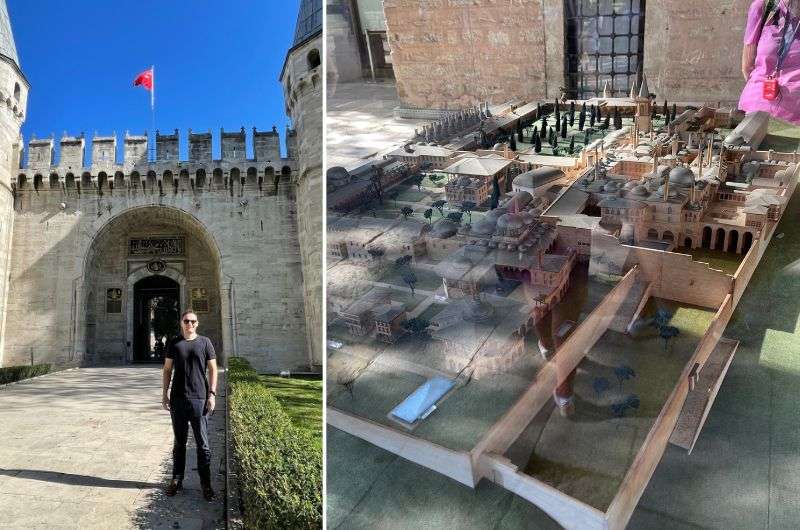
You can’t buy tickets in advance, but there are ways around this if you still want to skip the long lines at the entrance
And here comes another snag (especially for those who like everything arranged in advance): none of these tickets can be purchased online, but there's a workaround. This workaround is called the Istanbul Museum Pass, priced at 2,500 TL (about USD 82), granting access to all museums in Istanbul. It also acts as a Skip-the-Line ticket to Topkapi Palace.
However, I recommend checking Topkapi Palace's official website before visiting, as with the Turkish Lira, it's a bit of an uncertain season. For instance, two years ago, the museum card was 700 TL (USD 23) because the lira had a completely different purchasing power.
7. How long is the queue for Topkapi Palace?
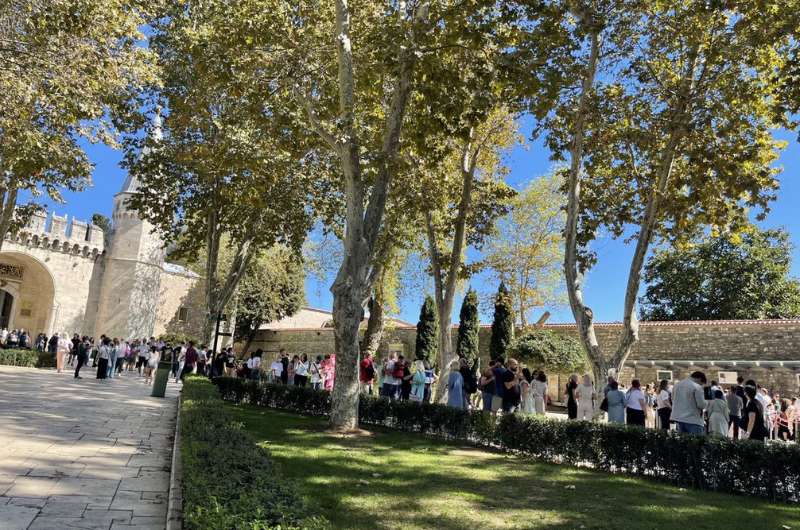
This long...
The line for Topkapi Palace averages around 40 minutes, but if you're unlucky, you might end up waiting for up to 3 hours. Yikes!
As I've mentioned before, if you're not a fan of waiting, you can purchase the Istanbul Museum Pass, which gets you into all museums in Istanbul (for 5 days) and allows you to skip the lines. Guess which option I went for. The looks on people's faces when they're miffed that you're "cutting" are priceless.
8. How long do you need at Topkapi?
Set aside at least 3 hours for visiting Topkapi Palace—that's the bare minimum, and you'll have to breeze through half of it. If you want to thoroughly explore the beauties of this palace, I recommend setting aside half a day. We consider ourselves relatively quick palace explorers, and even we spent 7 hours at Topkapi Palace.
You can fly through in a couple of hours (but why would you?) or spend all day there if you’re particularly keen on staring at the tilework for extended periods of time. There really is nothing better in all of Istanbul.
9. Do you need a guide for Topkapi palace?
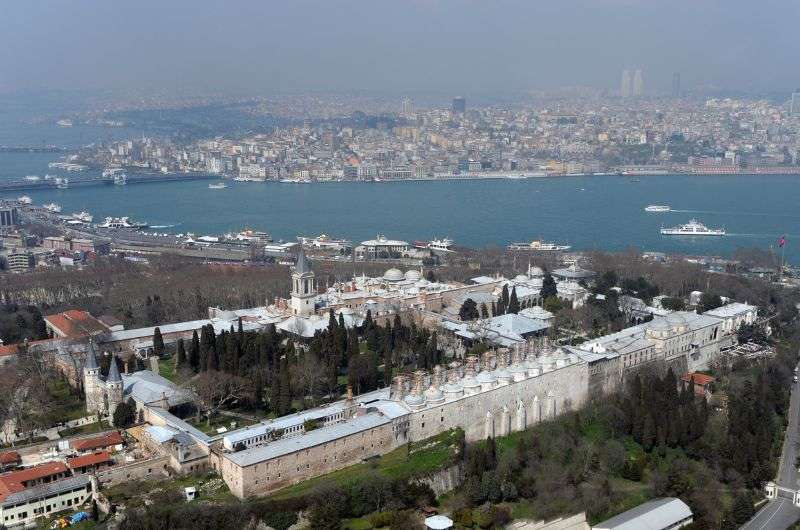
Topakpi Palace is really big. It takes at least 3 hours to walk around if you’re really, really fast
You don't need a guide to enter Topkapi Palace. But if you want to learn as much as possible and maybe ask some questions, I'd consider getting one. Personally, I'm not a big fan of organized tours because you have to keep pace with the group, so we went solo.
Nonetheless, you'll find plenty of guided tour options online. Just make sure the tour includes a visit to the Harem, as it's not included in all of them. And then brace yourself to pay a pretty penny.
We didn't use a guide; what we did use was an audio guide that you can download to your smart device. It costs USD 6 and is available in 9 languages. So, all that's left is to pop on your noise-canceling headphones and enjoy an uninterrupted tour (by nothing and no one, bliss!). I really enjoyed having the audioguide as It was nicely narrated and full of fun facts and now fluffing around.
10. What time does the Topkapi open?
Topkapi Palace is open every day except Tuesday. Opening hours vary slightly depending on the season. During the summer season (from April 1st to October 1st), it's open from 9 am to 6 pm. For the rest of the year, it's open from 9 am to 4:45 pm.
Topkapi Palace is closed on some major Turkish holidays, so you might want to check that before visiting. I'm not a Muslim, so I can't give you the exact dates, but I know they change every year, just like Easter does.
11. What is the dress code for Topkapi Palace?
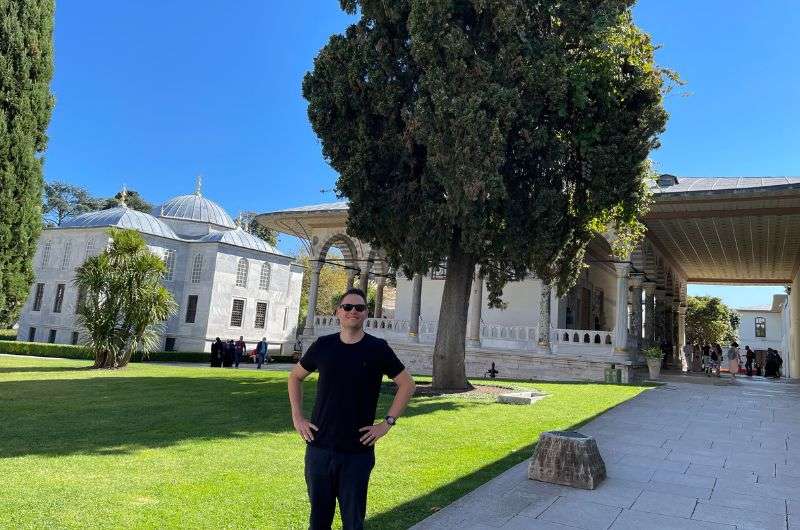
Wear long pants and a T-shirt with sleeves and you can enter anywhere
You can wear whatever you want at Topkapi Palace, apart from the Sacred Relics Department which forbids visible knees and shoulders.
That means while there is no dress code at Topkapi Palace, you can’t wear shorts, short skirts and dresses, and sleeveless anything if you want to enter the Sacred Relics Department. And those were very interesting, and you don’t want to miss them, so cover those offensive joints!
But honestly, you are still in Turkey so I would dress the part unless you want to attract some unwanted attention.
12. Can you take pictures in Topkapi Palace?
You can indeed take photos in Topkapi Palace. The rules specify that only amateur photography is allowed. So, if you're the type that hauls around lots of tripods and other equipment, leave all that back at the hotel this time. The only place where photography is prohibited is the museum within the palace. And there were really guards walking around preventing profi photography.
Tip: Speaking of hotels, my tips are these: 5-star: AJWA Sultanahmet, Vogue Hotel Supreme | 4-star: Fer Hotel, Boutique Saint Sophia
13. What can you see in Topkapi Palace?
The general layout of the palace consists of a series of pavilions built around 4 large courtyards. In its prime, the palace housed up to 4,000 people, so there are, in fact, a lot of rooms.
There were bits and pieces added almost continuously depending on the whim of the sultan in charge, so the palace has evolved over the centuries.
The best part for me was the gardens and all-over ambiance and structures from the outside. Ohh and of course Harem.
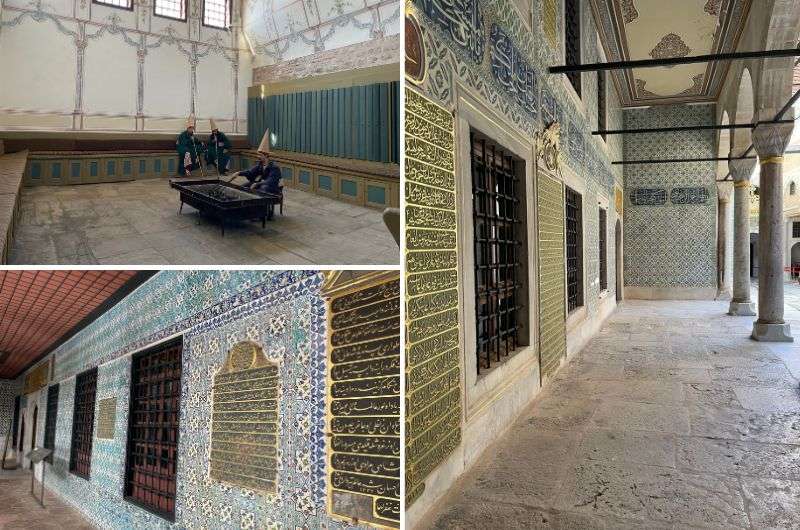
The tilework at Topakpi Palace is simply amazing
14. How many rooms does Topkapi Palace have?
Topkapi Palace has over 400 rooms. Don't worry, even though that number is huge, you won't be allowed into all of them. Only a fraction, in the lower tens, is open to the public. If you're worried that won't be enough, don't be. I walked through it quite briskly, and it took me over 5 hours.
15. What was the Harem of the Topkapi Palace?
The harem was the sultan’s family quarters, the area that was restricted to everyone else that wasn’t part of the Ottoman dynasty, namely any man that was not related… meaning the Queen Mother, the sultan’s wives, and their children, the concubines and their eunuch (castrated) guards were the only ones besides the sultan that could enter the Harem. It wasn’t some wild sex room, ok? A lot of people get this wrong, and I'll admit, I used to think that too.
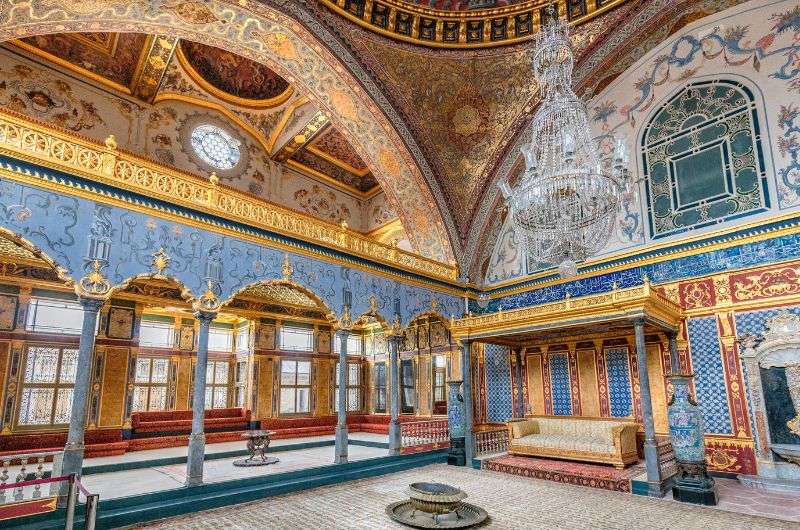
Topakpi Harem—the Sultan’s family quarters
Concubines were women who were accepted to the Topkapi Harem, schooled in Islam, culture, reading, writing, and skills such as music, dancing and embroidery. They then became a sort of assistant to the existing concubines, then to the family members.
Only the prettiest and most talented of the bunch moved up the ranks all the way to the sultan. Who then took them to the wild sex room. Dozens of them. But hey, give the guy a break, he was only allowed 4 official wives.
Only one of the six floors of the harem can be visited by tourists. You need to buy a combination ticket to be able to visit the Harem, or a separate ticket if you are on a tour that doesn’t include the Harem (see above).
Once you check out everything there is to see at Topkapi Palace, you can rest your legs and take in more of the views of Istanbul at the onsite café. It’ll be overpriced, and I wouldn’t eat there if I were you, but those views though! Opt for Turkish tea, not Turkish coffee! You’d know this if you’d read our Istanbul travel tips, where we warn you that Turkish coffee is awful. It tastes worse than the dirt water that they call coffee in Spain. Bleh.
16. What’s in the first courtyard of the Topkapi Palace?
The first courtyard (Alay Meydanı) forms the outer perimeter of the entire complex and is surrounded by high walls, serving as the entrance to the Topkapi Palace complex. It's the largest of all the courtyards (logically).
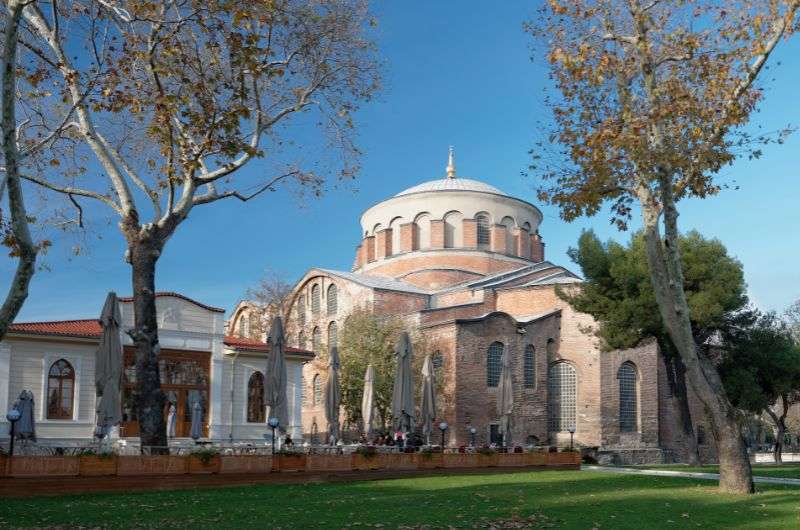
Hagia Irene church
In its heyday, this courtyard served as a space for public events, ceremonies, and parades. It was also the venue for various official events. Probably because it was about the only place where those 4,000 people could fit.
From this description, it might sound like the only thing this courtyard offers is walls, but that's not the case. Definitely don’t miss the chance to see possibly the oldest unrenovated building you’ve ever laid eyes on—the Haghia Irene from the 4th century. It’s a pre-Ottoman era church that is one of very few in the city that wasn’t converted into a mosque. They used to store weapons in it instead. The Haghia Irene is now a museum and concert hall.
Another surviving structure in the first courtyard is the former imperial mint (Darphane-i Âmire, built in 1727) and various fountains. So, you definitely have things to admire here. But to be honest, aside from the Hagia Irene, this part of the complex is the least interesting. So, I wouldn’t linger here too long.
17. How to see the second courtyard of Topkapi Palace?
You'll enter the second courtyard (Divan Meydanı) through the Middle Gate. These days, you can stroll right through (as long as you have a ticket). But back in Ottoman times, only the sultan and his mother could ride through the Middle Gate on horseback. Everyone else had to dismount and proceed on foot.
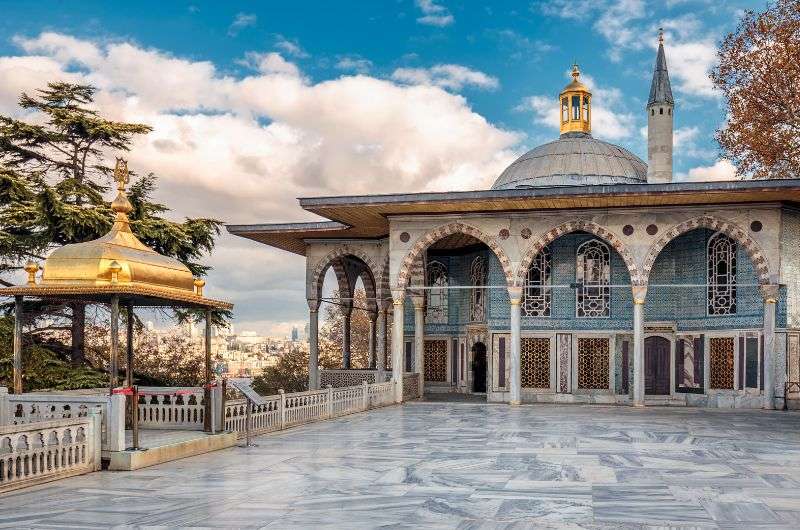
Divan Meydani courtyard
This was a key area of the whole complex. During the Ottoman era, the second courtyard functioned as a gathering place for courtiers. Imagine the Sultan sitting on a gilded throne, receiving an audience (fancy talk for meeting with people), usually subjects, envoys, or representatives of other states.
But these weren't just any meetings; they were ceremonies. And peacocks and gazelles roamed the courtyard... Why, you ask? I asked too, and apparently, it was part of creating an attractive and exotic environment. Who am I to judge?
The second courtyard hosted a range of significant buildings like the palace hospital, bakeries, the Janissary section, stables, the imperial harem, the Imperial Council Chamber, and the kitchens.
Imperial Council Chamber
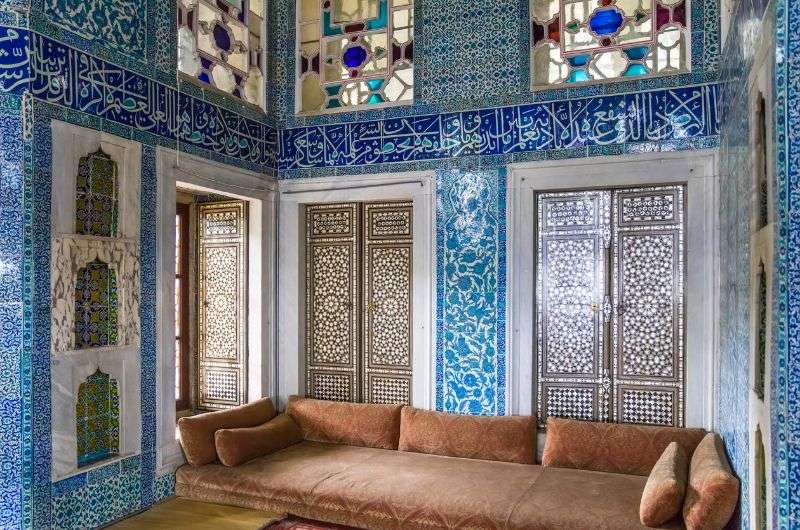
Imperial Council Chamber—a place where important political debates took place
The lavish Imperial Council Chamber served as the meeting place for the Imperial Council, the highest governing body in the Ottoman Empire, where major decisions regarding state affairs were made. It's clear the Sultan was the ultimate authority, but interestingly, he didn't attend the meetings. Or did he?...
The sultan would listen in on the meetings through a gilded window (or not, who knows), muahaha), so nobody really knew if he was listening in on them (or not). Interesting management technique, huh?
The palace kitchens
We thoroughly enjoyed this part, even though nobody's cooking there anymore. Mainly because of an amazing Chinese porcelain exhibit (but more on that later). Anyway, if you're imagining a kitchen similar to the one you have at home, you couldn't be further from the reality.
The Ottoman Empire's version of a kitchen means 10 domed buildings including a beverage kitchen and dairy, a confectionery kitchen, and more. They were the largest kitchens in the Ottoman Empire, preparing food for roughly 4,000 people with a kitchen staff of over 800. I wonder how Gordon Ramsay would manage shouting at that many chefs...
Tip: Speaking of food, check out my recommendations for where to eat well in Istanbul.
The Outer Treasury
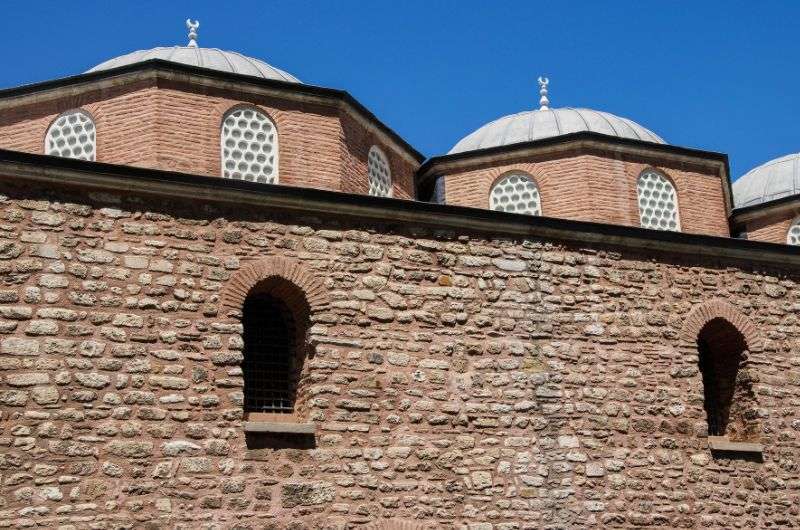
The Outer Treasury... from the outside
The Outer Treasury was of more interest to me, since this is where the arms and armor collection is displayed.
Originally, the imperial treasury also contained loads of interesting items, like gifts and financial assets used to fund state expenses, including rewards for officials, military campaigns, and diplomatic gifts. It's called the outer treasury because there was another one (surprisingly, an inner treasury) located in the third courtyard.
Gate of Felicity
This gate lives up to its name, and you really feel like you're entering into prosperity. It served as the main entrance to the inner palace. And of course, without the Sultan's permission, nobody could pass through this gate.
18. Can you get into the „privileged“ third courtyard?
The third courtyard, also called the Inner Palace (Enderûn Avlusu), is the heart of the Topkapi Palace. Only the sultan, his family members, his servants, and occasionally approved visitors could enter. You can imagine how special I felt stepping into this courtyard. Here too, a range of important buildings are located, like the library, the harem, and the treasury.
Audience Chamber
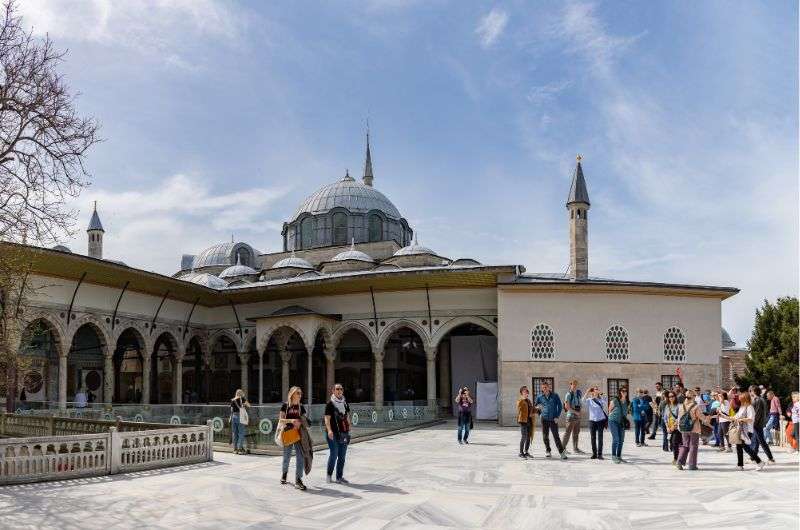
Audience Chamber
The Audience Chamber was a separate building where the great sultan received visits, held official audiences, and performed ceremonial functions. If you already thought the palace was one big piece of kitsch, just wait until you see the Audience Chamber. It's not that all sultans had such terrible taste, but the lavish decoration symbolized authority and power.
Besides the Audience Chamber, make sure to visit the Library of Ahmed III. It's a truly beautiful library, built in 1719.
19. What you can see in Sultan's sanctuary aka Fourth courtyard at Topkapi Palace?
If getting into the third courtyard was hard, accessing the fourth was practically impossible for anyone not related to the Sultan or the man himself. The fourth courtyard, also known as the Imperial Sofa, was essentially the Sultan's and his family's private sanctuary.
Circumcision Room
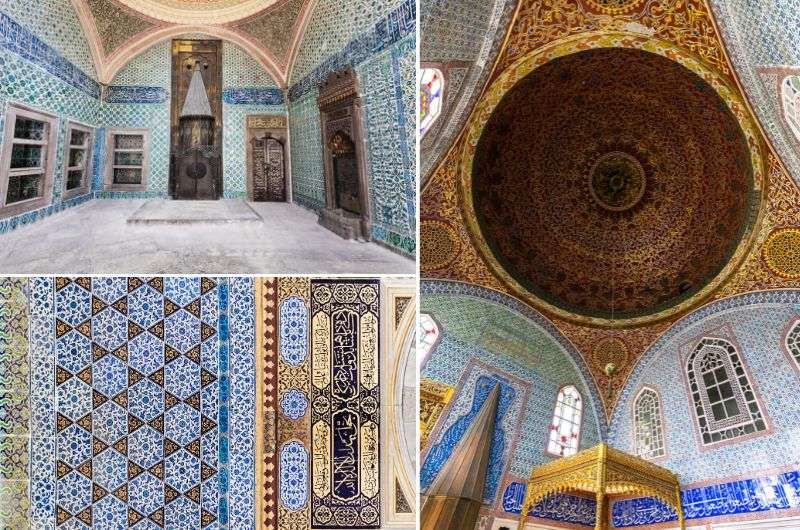
Tiles, tiles, everywhere. At least they had something nice to look at while getting snipped
Yes, you read that right. In the Sultan's sanctuary, there was a room for circumcising young princes. Islamic religious tradition, sometimes I'm really glad I'm an atheist. Stepping into that room gave me the chills, but I must admit, it was decorated excellently again. So over-the-top that you might even forget for a moment what it was used for.
20. What are the exhibits at Topkapi Palace?
At Topkapi Palace, you can explore the library, sacred relics, weapons, portraits of Ottoman sultans, the imperial treasury, and a vast collection of porcelain. Topkapi Palace was transformed into a museum in 1924 after the monarchy was abolished and the Turkish Republic was established. Three cheers for Ataturk, who turned Turkey into a republic and became its first president.
If you're a fan of weaponry, you'll really enjoy it here. During the reign of Sultan Mehmed II, Hagia Irene was turned into an armory for his army. It also served as a site for weapon manufacturing and repair. Hagia Irene functioned as an armory until the 19th century before being transformed into the museum we see today. It houses one of the richest collections of weapons in the world, featuring over 52,000 pieces from 13 different centuries. These are not only weapons used in Turkey but from all over the world. For me, this exhibit is far more interesting than the porcelain.
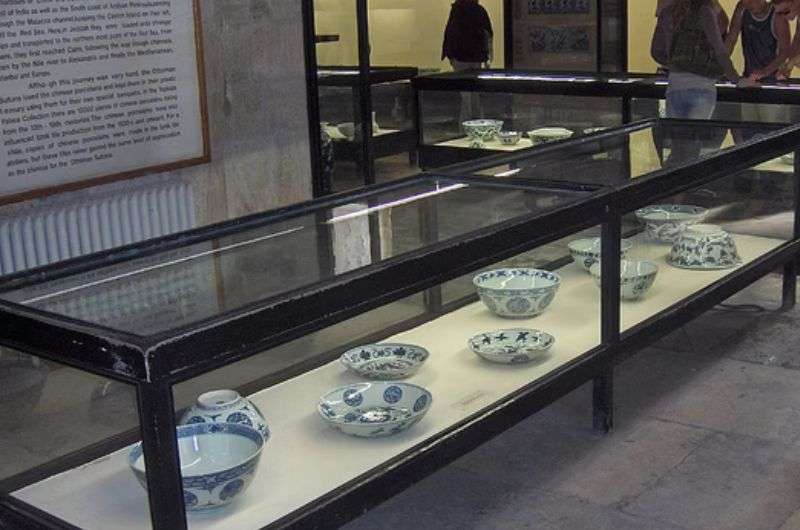
Porcelain fans, like my girlfriend, will be thrilled. As I mentioned at the beginning, the palace's decoration is beautiful, but I wouldn't want it at home. Yet, for a moment there, I felt like my girlfriend couldn't imagine life without a porcelain set (or ten). You'll find everything here: plates, basins, sweet dishes, jugs, cups and saucers, carafes, chandeliers, and candlesticks. You'll also find a collection of Bohemian glass here. For me as a Czech person, that's amusing (ironically), but I believe you'll like it.
I did learn something new about our glass. In the 17th century, Ludwig Moser, a manufacturer of luxury glass in Bohemia, created a set of six glasses and a carafe for Sultan Abdulhamid II. The set has been preserved and can be seen as part of the exhibition.
The Imperial Treasury is completely unique. Not only does it hold immense value (both historically and monetarily), but it's also a beautiful piece of art. Previously, the treasury was securely stored and only opened at the sultans' behest. It wasn't until Sultan Abdulmecid's reign that the treasury was opened to the public, and a few items from it were displayed.
These items now form the basis of the entire museum's collection. You'll find items sultans received for weddings, births of offspring, or even their circumcision celebrations. Besides, there are also items sultans sent as gifts that never reached their intended recipients and were returned. And let me tell you, those were some gifts!
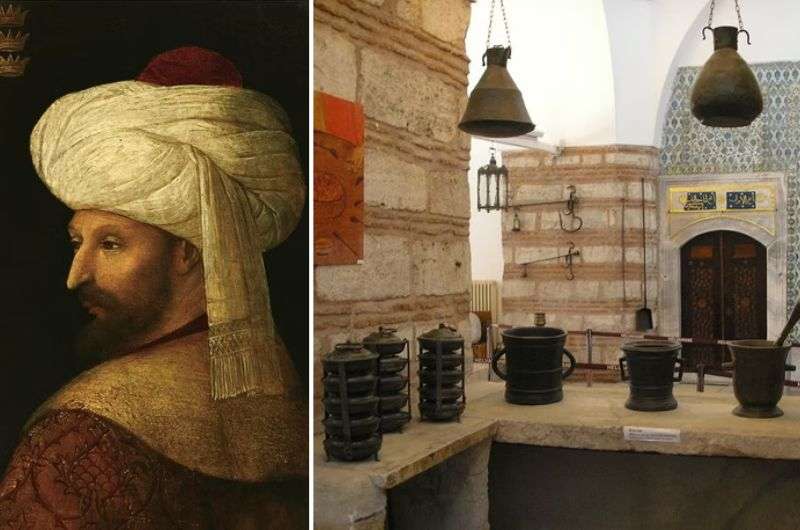
Next is the exhibition of 36 sultan portraits located in the Dormitory of the Privy Chamber. The most interesting piece here is the painting of Sultan Selim III's coronation ceremony by Konstantin Kapidagli.
Alright, that’s everything you need to know before you visit Topkapi Palace in Istanbul. If you’re psyched and ready to go, why not take a look at the other activities you can do in Istanbul besides sightseeing? Or, if you don’t know what to do with your time, maybe you’d like to ditch the city for a day on one of these 9 day trips (spoiler alert: you’ll need more than a day for at least 2 of them). Enjoy!
This post contains affiliate links. I earn a small commission if you make bookings through my links, at no additional cost to you. Thank you for your support!


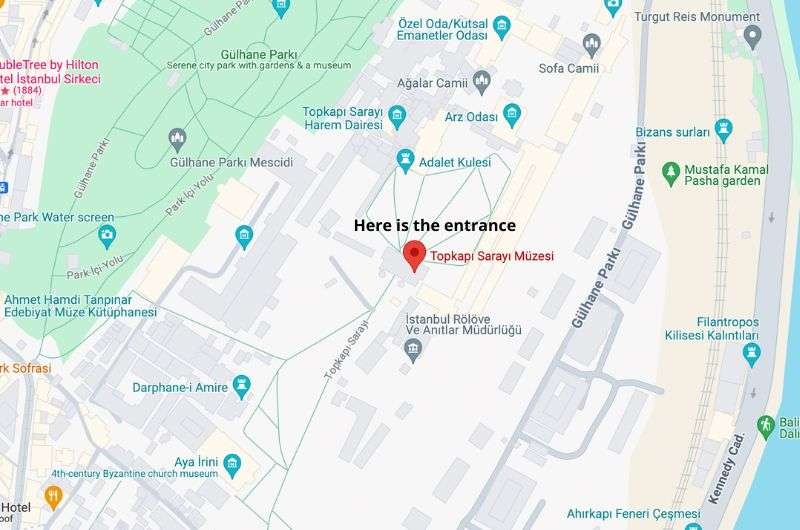
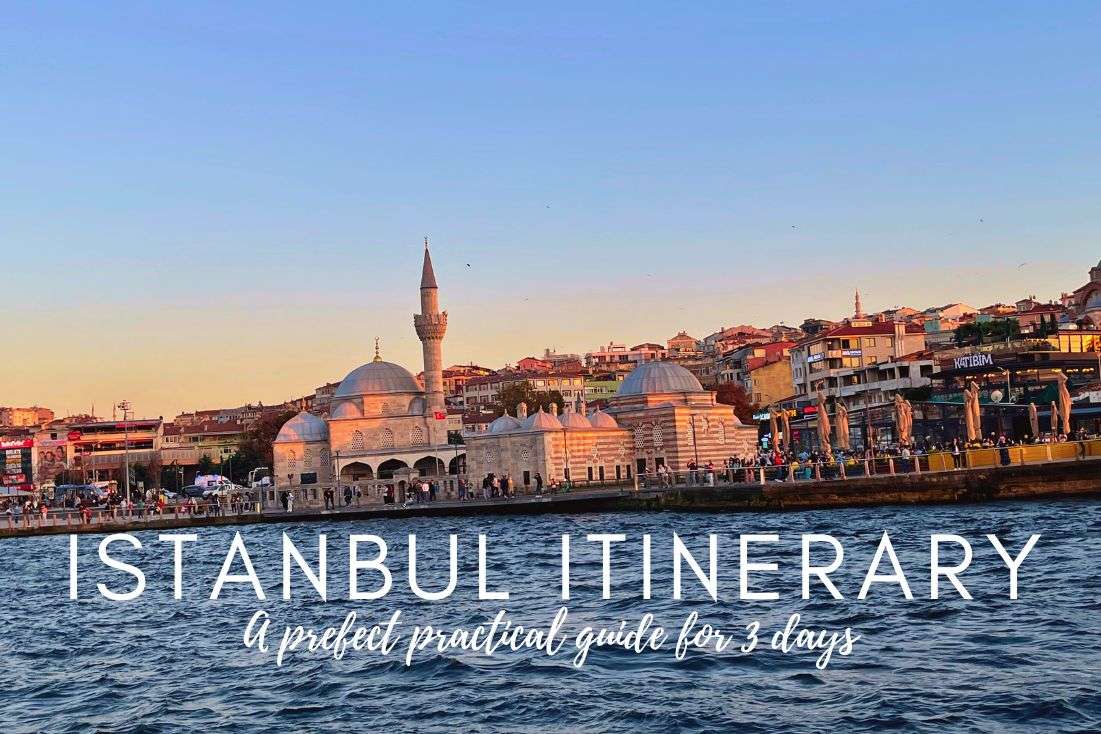

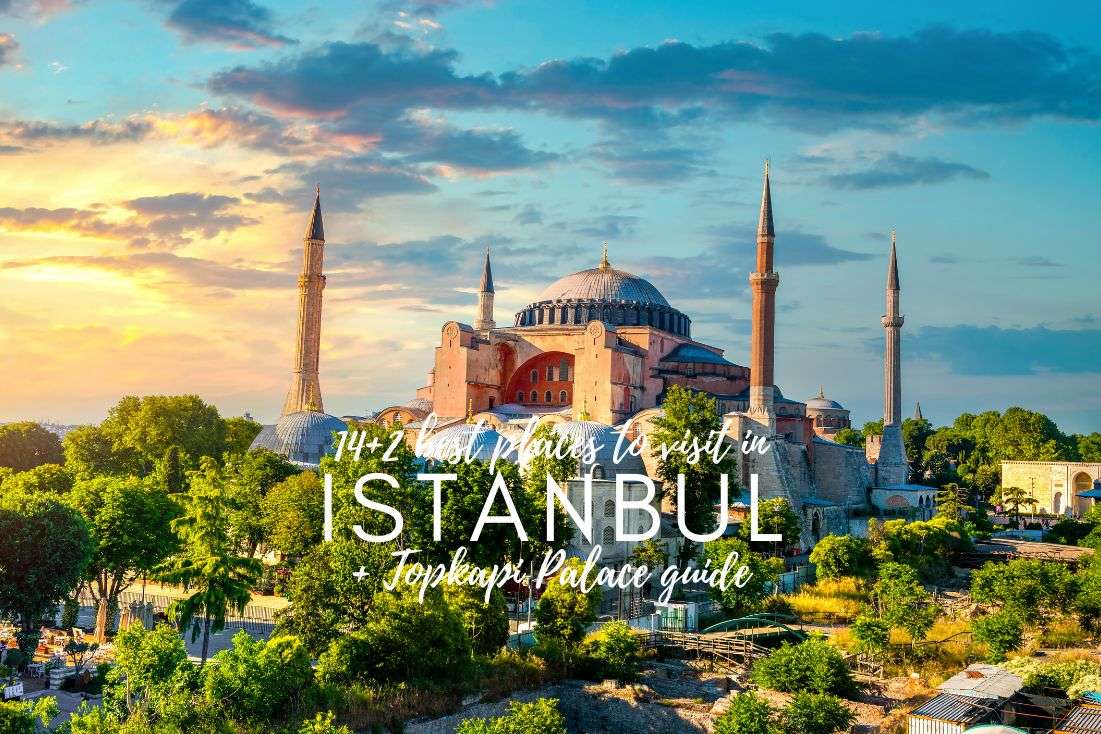





Comments | Thoughts? Give us a shout!